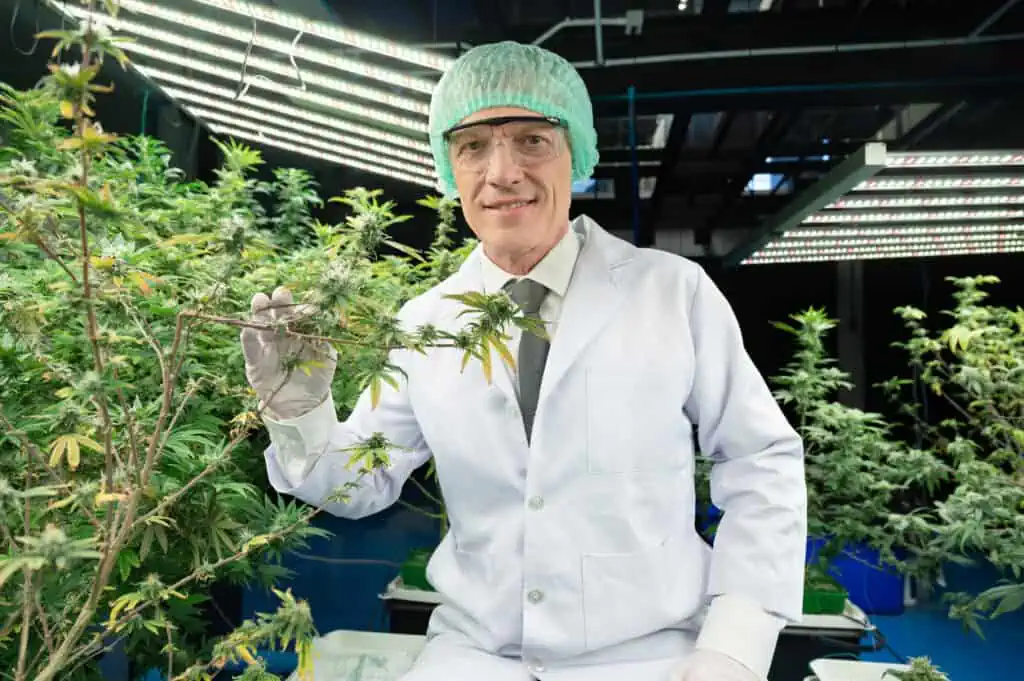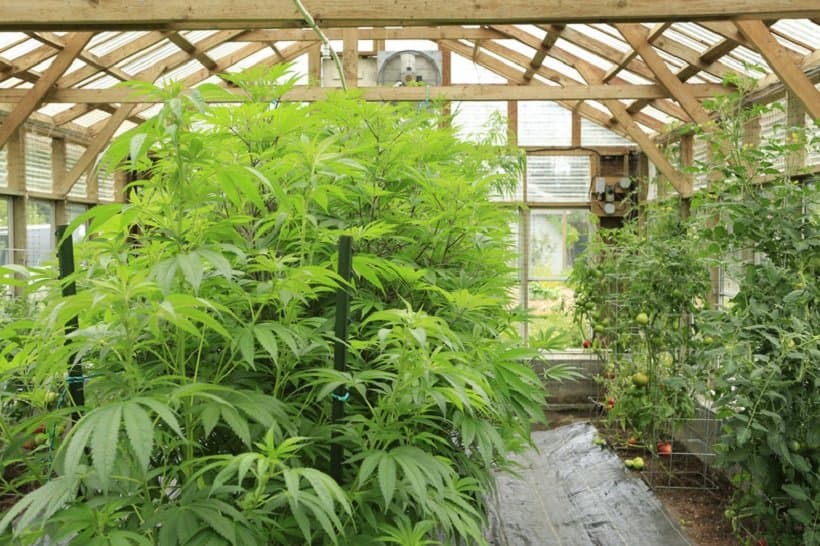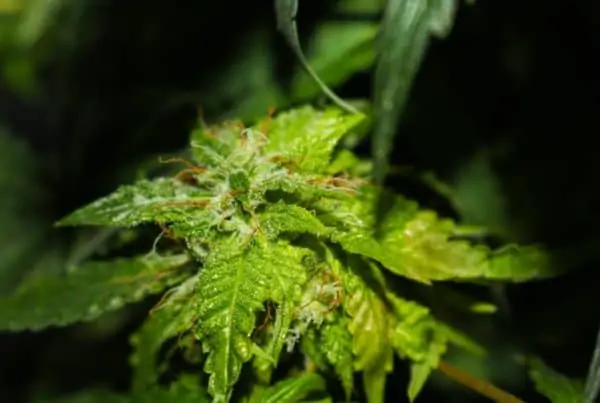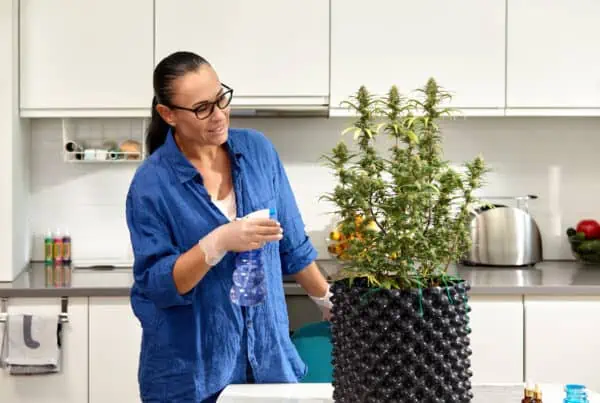TABLE OF CONTENTS
You can take several paths to become a master cannabis grower. Whichever path you take, you'll need the appropriate training and certification. If you are going to assume a position as a master cannabis grower, it is best to do it the legal way, especially if you are trying to build a career. Let's look at the different paths you can take on how to become a master cannabis grower.
Steps on How to Become a Master Cannabis Grower
Bud Trimmer
You can start as a bud trimmer and then work your way up to becoming a master cannabis grower. The bud trimmer works closely with a master grower, doing hands-on work at a certain point during the marijuana cultivation process. The bud trimmer works with the harvested flowers, snipping away the fan leaves and sugar with sharpened scissors.
The trimmer manicures the buds so that the THC content is optimized and the chlorophyll content is reduced for a better smoke. Trimming the bud also gives them a more aesthetically-pleasing look. Of course, bud trimmers have a boring job, but it is still an important aspect of the final product.
As a bud trimmer, you should work diligently to learn as much as you can about the various parts of the marijuana plant, its benefits and its behavior.
Keep in mind, bud trimming is an entry-level position that can become repetitive. Repetitive physical tasks for long periods can cause injury in the hand, wrist, and arm. However, trimming is a great first step for those thinking of growing (pun intended) their career in the cannabis cultivation space. Plus, trimming jobs don’t usually require any formal training. You just need to be a hard and reliable worker.
Requirements: Cleanliness, organization, reliability
Average Salary: $12-18/hour or based on pound of weed trimmed
Grow Assistant
The Grow Assistant works closely with the master cannabis grower. The master grower is like a supervisor to the Grow Assistant. And so, it is like training on the job.
Some people already have experience and training, but not everyone does. The Grow Assistant should use this opportunity to learn as much as possible from the master grower.
Requirements: Science or horticulture degree preferred; experience working at a cultivation site and knowledge about growing techniques, supplies, and equipment
Average Salary: About $15/hour
Budtender
As a budtender, you will be in a sales and customer service position of employment. You have to be equipped with sufficient knowledge about the cannabis business and industry. This includes learning about various marijuana strains.
If you stay on the job long enough, you will learn enough to leave and become a master cannabis grower. There are some marijuana dispensaries that will add to the budtender's responsibility and require bud trimming. This does not happen in all cases.
Requirements: Knowledge about cannabis, strains, state and local laws, and different delivery methods
Average Salary: About $15-25/hour
Cannabis Training & Certification
For most entry-level cultivation positions, you won’t need any formal training. Some companies will require a high school diploma or GED at a minimum. College degrees may be preferred.
If you want to become a master cannabis grower and be taken seriously in the industry, it is better to receive industry training. While you can get on-the-job training, specialized training has more impact.
Most training programs will usually last for six months or less. You get to set your own schedule and work at your own pace, which is really cool for students who work full time at another job.
A master grower job can be found anywhere that marijuana has been made legal. Many related websites will allow you to do an advanced search. It is best to acquire cannabis training first before you begin your search. Cannabis Training University is the leading cannabis school for learning how to grow cannabis and get a job as a cannabis grower.
Understanding Cannabis Fundamentals
Master cultivators must understand every aspect of the cannabis cultivation and breeding process. Managing hundreds of different varieties of cannabis in various grow settings including indoor, outdoor, and greenhouses require in-depth knowledge of clones, seeds, flowers, vegetative growth, flowering period, and more cannabis cultivation terms and topics.
Managing large-scale facilities require master growers to understand the optimal growing conditions for each specific strain. Master growers must know everything about a strain’s nutrient intake levels, pest control solutions, pH levels, and more to keep it healthy. Growers must be aware of and regularly monitor ventilation, humidity, water, temperature, and other environmental factors.
Master cannabis growers must delegate a skilled team to help them oversee all aspects of the cultivation process. To do so, growers must have a firm grasp of cannabis cultivation topics such as cloning, transplanting, feeding, defoliation, topping, flushing, trimming, packaging, waste disposal, and inventory management.
Part of running a commercial grow facility also means understanding all the state and county cultivation regulations and how to comply with them. Weed growers must deal with state inspections and track certain information to submit to the state. Non-compliance with the cultivation rules could result in fines or a flat-out license removal.
Minimum Age Requirement
In order to be a master cannabis grower, you must be of a certain minimum age in order to apply. Minimum age requirements vary by state and company. Generally, cannabis cultivation positions require you to be at least 21 years of age.
Master Cannabis Grower Job Description & Salary
A marijuana master grower must be able to manage large-scale and state-of-the-art cultivation facilities. Licensed cannabis producers look for top-tier talent who have a long history in horticulture and cannabis growing. A master grower must also possess adept management skills to lead a team of assistants, trimmers, and other staff.
Cannabis growers can have various levels of education, but must have at least five years of experience managing commercial cannabis or hemp growing operations. A master marijuana grower’s job description includes the following responsibilities:
- Manage and maintain cannabis grow house protocols
- Meet the production goals
- Hiring and training a team of employees
- Lead a team of highly competent employees
- Analyze and track each strain from seed or clone to harvest
- Document expenses, plant nutrition, and other facility operations
- Use preventative measures against contaminants
- Maintain a clean and organized work environment
- Remain compliant with state regulations
A master grower’s salary depends on experience, skill, and location. Master growers command some of the highest salaries in the industry. A cannabis company depends on the master grower’s cultivation capabilities. For the highest-earning master growers, companies are paying $250,000 to $300,000 a year.
On average, a master cannabis grower can earn between $120,000 to $150,000 a year. The highest earners will have previous experience running a commercial operation and working with government regulations. On the lowest end of the salary spectrum, master growers can earn between $60,000 to $90,000 a year for an entry-level grower.
Master Cannabis Grower: Soft Skills & Physical Requirements
Master growers do more than just grow cannabis or hemp. The best job candidates have excellent people-management, delegation, and conflict-resolution skills. They must be effective communicators and interact knowledgeably with investors, staff, and media. Growers must also have remarkable time-management skills to manage the cultivation and office-related tasks.
In terms of physical demands, a master grower must endure long periods of standing, sitting, walking, and moving around the facility.
Growers must also be able to visually inspect the plants. They must be able to perform repetitive motions during trimming and harvesting.
Finally, growers must be able to lift up to 50 pounds for 100 feet according to many cultivation job descriptions.
Master grower positions require long hours on-site managing facilities starting at 20,000-square-feet in size and higher.
This cultivation position can be fun and rewarding, but it requires a lot of patience, hard labor, and a heavy load of responsibilities.
How To Find A Cannabis Cultivation Position
Before you decide to apply for a cannabis cultivation position, you’ll want to do as much research as you can about the industry and the cultivation space in particular. Knowing about state regulations and the inner workings of growing weed can prepare you for a career in this segment.
- Stay up-to-date with the latest industry developments by reading industry blogs including the CTU blog.
- Read books about cannabis cultivation from industry professionals like the master of ganja, Ed Rosenthal.
- Enroll in cannabis education training
Cannabis Education
One of the best ways to start your career as a cannabis grower is to get a strong educational foundation. Cannabis Training University provides you with affordable online training.
Whether you’re a beginner or a seasoned user, CTU’s curriculum provides an approachable start to a career in the industry. ‘Explore a wealth of up-to-date resources on various cannabis topics written by industry professionals. Know exactly how to create a resume and cover letter and excel in the interview with online cannabis college.
Cannabis Job Boards
Check a variety of major job boards such as Indeed, ZipRecruiter, Monster, and LinkedIn for the best cannabis job openings. Craigslist can also offer tons of opportunities in cannabis cultivation.
Industry Events
Find a marijuana cultivation job by attending cannabis trade shows and conferences. Industry events are great for networking opportunities. Make a personal introduction, exchange business cards, submit your resume, and ask about any cultivation openings. Trade shows allow you to go directly to the recruiter and make a lasting impression.
Interview
Let’s say your glowing resume won them over. Now it’s time to prepare for the interview. Go through solutions to different cannabis growing obstacles your future employer may be having.
Also, don’t be afraid to ask questions to get to the root of a growing-related problem. As long as you provide thoughtful and knowledgeable answers, you have a winning chance of getting hired.
Background Screening
Depending on state regulations and company policy, you may need to undergo a comprehensive background screening. Some states require background checks to determine if industry applicants have a disqualifying conviction.
Generally, repeat and violent offenders or those that have sold to minors are disqualified from applying to jobs in the industry. However, there are many states that have expunged past cannabis criminal convictions and are currently working on removing more from the system.

Work Permit
Some states require applicants to obtain a cannabis workers permit. Permits may involve a background check, fingerprinting, certification/training, and an application fee (fees waivers may be available).
Requirements vary by state. Training is required to teach employees about remaining compliant with state and local regulations. Work permits may require annual renewals.
Get Ready to Work
Getting hired as a bud trimmer or grower’s assistant is the first step in a long journey to become a master cannabis grower. Be prepared to learn on the job and troubleshoot common cultivation issues such as disease and pest contamination on the fly.
Adapting to everyday problems can keep operations running smoothly. From ensuring all plants have enough water and nutrients to maintaining the optimal temperature and humidity levels to harvesting the buds at the end of the growing season, you’ll gain experience while learning directly from the head grower.
Regardless of your cultivation job, you’ll be required to sanitize and disinfect your growing equipment tools such as shears, gloves, clothing. Most cannabis cultivation jobs will be either part-time or full-time with 8-hour shifts from Monday to Friday.
Advancement Opportunities
Many cannabis companies will promote within the company. Starting off as a bud trimmer or grower’s assistant is the first step toward gaining more responsibilities and a deeper understanding of running a large-scale commercial cultivation facility. Additional cultivation positions include:
- Plant Health Supervisor
- Cultivation Engineer Coordinator
- Phenohunt Specialist
- Plant Tissue Culture Laboratory and Regional Supervisor
- Cultivation Inventory Specialist
- Post-Harvest Manager
- System Control Specialist
Master Grower FAQ's
What qualifications are needed to become a master grower of cannabis?
In most cases, a master grower is someone who has a significant amount of experience in both horticulture and cannabis production. Obtaining a formal education in botany, horticulture, or a field that is closely related is quite advantageous. It is absolutely necessary to have knowledge about cannabis genetics, nutrient regimens, pest management, and environmental control systems, all of which can be learned at Cannabis Training University.
How much experience is required to be considered a master grower?
Depending on the circumstances, the minimum requirement is typically many years of practical expertise in the growing of cannabis. One must be knowledgeable with both the practical and technical aspects of cultivating cannabis on a commercial scale in order to fulfill this requirement. Many Master Growers start as an assistant cannabis grower and work their way up.
What are the primary responsibilities of a master grower?
A master grower is responsible for overseeing the entire process of cultivating cannabis, which includes cloning, transplanting, feeding plants, defoliation, topping, flushing, foliar feeding, harvesting, and curing. Moreover, they are responsible for the management of growing procedures, pest control, and quality control.
Can I become a master grower by self-teaching?
Even while it is feasible to teach yourself through experience, participating in formal education can considerably improve both your knowledge and your skills. Self-taught experience, official education, and ongoing education are all components that many master growers include into their practise. Cannabis Training University has online programs for cannabis cultivation that will assist anyone looking to become a Master Grower.
Are there specific certifications or courses for becoming a master grower?
There are, in fact, specialized classes and certifications that can be obtained in the field of cannabis production and gardening. The numerous facets of cannabis biology, production practices, and industry compliance are all covered in these seminars. Cannabis Training University offers online courses in all facets of cannabis cultivation methods.
What is the average salary for a master grower of cannabis?
Location, years of experience, and the magnitude of the business all play a role in determining the wage. Master growers have the potential to make a substantial wage, frequently reaching well into the six figures, particularly in well-established areas.
What skills are essential for a master grower?
Some of the most important talents are having a comprehensive understanding of plant biology, being proficient in a variety of cultivation techniques, being able to solve problems, being a leader, and being able to work in conformity with regulations. In addition, having technical expertise in areas such as hydroponic systems, lighting, and environmental controls is quite valuable.
How important is legal knowledge in the role of a master grower?
Extremely significant. Master cultivators are required to have a comprehensive understanding of the legal elements of cannabis production, which includes the observance of state and federal laws, the fulfillment of license requirements, and the adherence to health and safety rules.
What are the challenges faced by master growers in the cannabis industry?
Keeping up with the quickly shifting cannabis legislation, managing large-scale production operations, addressing concerns related to pests and diseases, and guaranteeing consistent product quality and yield are all challenges that must be overcome.
How can I stay updated with the latest cultivation techniques and industry trends?
Maintaining a current knowledge base demands ongoing cannabis education. Attending industry conferences, taking part in online communities and forums, subscribing to industry magazines, and networking with other professionals working in the cannabis sector are all ways to accomplish this goal.
“
There are over 300,000 jobs in the cannabis industry. CTU trained me for one of them!

Makes $24.50 @ THC +
Final Thoughts on How To Become a Master Grower
Master Grower Certification
As cannabis cultivation’s popularity grows, the competition for the master grower position will become even more competitive. Stay ahead of the competition by getting a master grower certification.
Enrolling in an online cannabis college is not required, but can give you the knowledge you need to start a career in the cannabis cultivation field.
Enrolling in Cannabis Training University’s online cannabis training programs gives you an in-depth look at how you can go from a complete beginner to a master grower in no time. Course instructors are innovators in the cultivation space.
Learn how to grow on a budget from the best in the business. Jumpstart your cannabis garden with affordable equipment, nutrients, and supplies.
We’ll teach you basic and advanced cultivation techniques for indoor and outdoor growing.
CTU is the most affordable and renowned cannabis college that offers you a well-rounded cannabis curriculum. You can learn how to become a master cannabis grower from anywhere in the world. All you need is an internet connection and a computer, smart phone, or tablet.
Watch hundreds of hours of videos and read thousands of pages of ebooks full of invaluable information about cultivating cannabis.
Always remember that a master grower's job is very important to the fabric of the company and so your contribution is essential. This is the kind of job that makes you into an expert with ongoing practice. Before you know it, you will be moving into your own cannabis business.
Learn more about how to become a master cannabis grower when you enroll in Cannabis Training University.

Luis Cordova
Luis Cordova is a distinguished author, and renowned expert in cannabis cultivation, who possesses a Master's degree in Plant Biotechnology and Pharmaceutical Science. As a valued contributor to highly esteemed publications such as Cannabis Training University and Maximum Yield Magazine, Luis has emerged as a trusted source of guidance and knowledge in the cannabis industry. Having written thousands of informative articles, Luis is widely recognized for his comprehensive expertise on cultivating cannabis, both indoors and outdoors.












 Jeff was involved in an accident where he endured a traumatic brain injury. He had a week-long stay in ICU where brain surgeons
Jeff was involved in an accident where he endured a traumatic brain injury. He had a week-long stay in ICU where brain surgeons  100% risk free money back guarantee within 48 hours after purchase if student has not completed any of the courses or exams.
100% risk free money back guarantee within 48 hours after purchase if student has not completed any of the courses or exams.